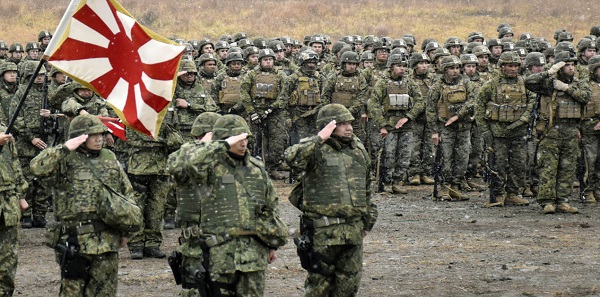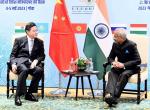The above quote succinctly conveys Shinzo Abe’s situation regarding his efforts towards revising the Japanese constitution. Just six months ago, after the Lower House elections, Shinzo Abe was touted to be on the path of becoming the longest serving Japanese Prime Minister in history. When North Korea conducted its sixth and largest nuclear test of a thermonuclear bomb, Abe was seen as the strongman to lead Japan through troubled times. But with strong backlash on alleged favouritism scandals to cover up of Japanese Self-Defence Forces (SDF) overseas deployment logs, Abe is close to approaching the ‘death zone’ (aka below 30 percent) in public ratings. On April 14, a protest rally in Tokyo demanding resignation of Abe saw participation of nearly 50,000 people, one of the biggest such rallies in three years. There are doubts now on whether he will receive a third term as the ruling Liberal Democratic Party (LDP) President after its leadership election in September. In fact, former Prime Minister and mentor of Abe, Junichiro Koizumi raised speculations that he might resign once the parliamentary session ends in June1.
In contemporary time, Abe is the most outspoken Japanese Prime Minister on the agenda of revising the post-war Japanese Constitution. According to Abe, an amendment of Article 9 (assigning legitimacy to SDF) is necessary to rejuvenate Japan and enable it to be a security provider both for itself and in the region. It was during his first stint as the prime minister that the Defence Agency was elevated (after 53 years) to the level of Defence Ministry in 2007. Under his office, the first National Security Strategy was outlined that emphasised a ‘Proactive Contribution to Peace’ on Japan’s part and even broke the sacrosanct one percent ceiling of Gross Domestic Product (GDP) on defence spending. Abe further introduced the most extensive legislation in Japan’s security policy – National Security Legislation - which allowed the SDF to operate overseas for collective self-defence. He also lifted the total ban on arms exports and passed the State Secrets Law that had been abolished under the Allied Occupation period. In March this year, Japanese Ground SDF underwent its most significant structural reform since its formation in 1954 with the creation of a unified command and the launch of an Amphibious Rapid Deployment Brigade (ARDB) tasked with defending Japan’s remote islands.
On June 20, 2017, the Research Committee on Security within the ruling LDP released an interim report with recommendations for Japan’s next National Defence Policy Guidelines (NDPG) and Mid-Term Defence Program (MTDP) for fiscal years 2019-20232. The interim report supported the increase of Japanese defence budget to 2 percent of GDP and pushed for acquisition of “counter-attack” capabilities. The NDPG sets forth the basic policies for Japan’s security, specific organisation of the SDF, the building up of Japan’s defence capabilities, and the deployment targets for major equipment. The MTDP specifies the review of major units, major projects concerned with the capability of the SDF, policies to strengthen the Japan-US Alliance, maintenance scales of main equipment, and required expenses. 2019 would see the sixth revision (1976, 1995, 2004, 2010, 2014 and shortly 2019) of NDPG and MTDP. The constancy and frequency of revisions in the NDPG and MTDP indicate the steady and undeniable change in the fabric of Japan’s pacifist security structure.
A study released in redacted form by Japan’s Ministry of Defence on April 27, 2018 asserted that the helicopter destroyer JS Izumo, along with its sister ship, JS Kaga, can be turned into fully fledged aircraft carriers. With certain modifications, the Izumo-class can operate the F-35B, capable of vertical or short takeoffs and vertical landings (STOVL) without requiring a catapult launcher from the warship’s flight deck3. The Japanese Maritime SDF is also expected to acquire 22 submarines by the mid-2020s as specified in the NDPG 20144.In fact, with potential aircraft carriers and large number of submarines, it would not be an overstatement to say that Japan has serious latent maritime power capability which can be called upon in times of crisis. With Donald Trump assuming the presidential office in the US, the wave of these changes further gains prominence. Under Trump’s ‘America-First’ policy, Japan remains anxious on the US’s security commitment to Japan and the region. Interspersed with North Korea’s recent summit diplomacy with China, South Korea and shortly with the US, Japan is in a precarious position of being relegated to a tier-two power position.
Though in recent years, loyalties to the prime minister and central leadership have superseded loyalty to the factions, factional politics may once again reemerge as deciding factor in LDP presidential elections. It is still too early to write off Abe who enjoys support from the largest (Hosoda) faction in LDP- that has 95 members. The other two candidates tipped for the top LDP job are Shigeru Ishiba, a former Defence Minister and former Secretary-General of the LDP and Fumio Kishida, a former Foreign Minister and current Policy Research Council chairman, one of the top three positions in LDP. Although Ishiba has only 19 members in his Suigetsukai faction - one short of the 20 threshold required to nominate a challenger for the leadership of the party, he is popular with the public. In an April 2018 Asahi Shimbun survey, Ishiba was picked by 27 percent of respondents as most suitable for next LDP President, followed by Abe at third position with 22 percent. Kishida received support from 6 percent of respondents5. On the other hand, Kishida’s Kochikai faction, once a mainstream liberal faction in the LDP has seen four Prime Ministers - Hayato Ikeda, Masayoshi Ohira, Zenko Suzuki and Kiichi Miyazawa. Kochikai presently has 46 members.
Ishiba’s views on Constitution Amendment are fairly well-known. He is starkly opposed to Abe’s proposal to insert a third para in Article 9, and instead calls for an outright overhaul of the article. Kishida, on the other hand in a press conference (as the foreign minister at the time) mentioned that his opinion has not changed since 2015, when he said he was against an immediate revision to the pacifist Article 96. Kochikai was last in power in 1993. Under Kiichi Miyazawa, the first of major new security legislations was (twice) introduced- International Peace Cooperation Law (IPCL) and passed in 1992. The IPCL amended the SDF Law to allow the Japanese SDF to participate in UN peacekeeping operations. Thus, it is difficult to presently ascertain continuity of Kochikai’s moderate security policy in the continually changing security environment (if they were to assume power). With Upper House elections in July 2019, the LDP presidential elections in September this year are significantly important for the LDP.
Further, the mandated public referendum becomes the make-or-break factor. Article 96 of the Japanese Constitution states that a two-thirds majority in both houses of the Diet, followed by a majority in a public referendum is necessary to institute a constitutional amendment. As the United Kingdom European Union membership referendum in 2016 (aka the Brexit referendum) showed, public opinion is difficult to predict. LDP, the dominant Japanese political party, has majority consensus on revising the constitution, though the approach remains highly contested. On March 22 this year, veteran LDP lawmaker Hiroyuki Hosoda, head of the ruling party's Headquarters for the Promotion of Revision to the Constitution, received the green light from the LDP headquarters to move forward with a proposal to revise Article 97.
In summing up, it is still too early to write Abe off. Yet in the post-Abe Japan, one can envisage the continuation of the constitution debate and the larger leap to increasing independent security capabilities to not only strengthen Japan, but also the US-Japan security alliance.
References
1. Japan Times: April 16, 2018, Former Prime Minister Koizumi sees embattled Abe quitting in June: magazine, https://www.japantimes.co.jp/news/2018/04/16/national/politics-diplomacy/former-prime-minister-koizumi-sees-embattled-abe-quitting-june-magazine/#.WuwlK4iFPIU
2. The Diplomat: Yuki Tatsumi, June 23, 2017, All About the Yen: Japan Begins Mid-Term Defense Planning, https://thediplomat.com/2017/06/all-about-the-yen-japan-begins-mid-term-defense-planning/
3. The Diplomat: Franz Stefan Grady, May 2, 2018, Study: Japan’s Largest Warship Can Support F-35B, https://thediplomat.com/2018/05/study-japans-largest-warship-can-support-f-35b/
4. Japan Ministry of Defense: Defense White Paper 2017, Part II: Japan’s Security and Defense Policy and the Japan-U.S. Alliance, Section 3 Build-Up of Defense Capability in FY2017, http://www.mod.go.jp/e/publ/w_paper/pdf/2017/DOJ2017_2-2-3_web.pdf
5. Asahi Shimbun: April 16, 2018, Asahi poll: Ishiba preferred over Abe for next LDP president, http://www.asahi.com/ajw/articles/AJ201804160037.html
6. Ministry of Foreign Affairs of Japan: Press Conference by Foreign Minister Fumio Kishida, May 9, 2017, http://www.mofa.go.jp/press/kaiken/kaiken4e_000370.html
7. Mainichi Shimbun: March 23, 2018, LDP panel decides on Article 9 revision proposal amid predictions of resistance, https://mainichi.jp/english/articles/20180323/p2a/00m/0na/009000c
(The paper does not necessarily represent the organisational stance. The author certifies that the article/paper is original in content, unpublished and it has not been submitted for publication/web upload elsewhere, and that the facts and figures quoted are duly referenced, as needed, and are believed to be correct).
Image Source: https://www.japantimes.co.jp/news/2017/12/22/national/politics-diplomacy/japanese-cabinet-oks-record-¥5-19-trillion-defense-budget-counter-north-korea-interceptor-batteries-first-cruise-missiles/











Post new comment